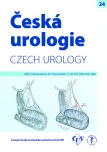Our approach to diagnosing and treating impalpable testis
Authors:
Jan Šarapatka; Zuzana Seifriedová; Oldřich Šmakal
Authors‘ workplace:
Urologická klinika LF UP a FN v Olomouci
Published in:
Ces Urol 2020; 24(2): 126-131
Category:
Original Articles
Overview
Introduction: The diagnosis and treatment of an impalpable testis remains a controversial issue. The aim of the study was data analysis in boys operated on for an impalpable testis.
Material and methods: In a retrospective study, we evaluated the findings in 228 boys who had been operated on for an impalpable testis at the Department of Urology of the Olomouc University Hospital in the years 2017 and 2018. To diagnose cryptorchidism, we perform a physical examination. In patients with a palpable testis, orchidopexy from the inguinal approach is our treatment of choice. If, in patients with an impalpable testis, palpation under general anaesthesia fails to show the presence of a testis, we begin with an exploration of the inguinal canal. If a viable testis is found, we continue with standard orchidopexy; in the case of its high location, we choose orchidopexy with retroperitoneal mobilization of the vas deferens and vessels. If atrophic testicular residue is found, we perform orchidectomy. If no testis, testicular residue or vas deferens are found, we proceed to exploration of the abdominal cavity. If the finding is a macroscopically normal testis, we carry out one-stage orchidopexy with interruption of the vascular supply according to Fowler-Stephens. If an atrophic testis is found, we perform orchidectomy; when there is evidence of agenesis, the procedure is terminated.
Results: The study included 228 boys, with bilateral cryptorchidism being diagnosed in 29 of them (12.7%). A total of 257 testes were operated on: 197 testes were palpable (76.7%) and 60 (23.3%) were impalpable. In the case of an impalpable testis, the testis or its residue was located in the groin 27 times (45.0%). In 13 viable testes, we performed orchidopexy; in 14 cases, fibrous tissue of an atrophic testis was removed. Intra-abdominally, a testis, its atrophic residue or only a vas deferens was found 33 times (55.0%). Twenty-two testes were located within 2 cm from the internal ring, including a peeping testis, and orchidopexy was carried out. In two cases, high intra-abdominal retention (more than 2 cm from the internal ring) was present, and we performed Fowler–Stephens orchidopexy. In two cases, atrophic testicular tissue was found and removed. Testicular agenesis was diagnosed in seven cases.
Conclusion: To diagnose and treat an impalpable testis, an exploration of the inguinal canal was sufficient in most cases, i.e. in a total of 49 testicles (81.7%). A subsequent exploration of the abdominal cavity had to be performed in 11 (18.3%) impalpable testes.
Keywords:
laparoscopy – Cryptorchidism – impalpable testis – inguinal approach
Labels
Paediatric urologist Nephrology UrologyArticle was published in
Czech Urology

2020 Issue 2
Most read in this issue
- Renal tumor biopsy – indications, technique, results
- Examination of circulating tumor cells in renal carcinoma
- Objemný cystický lymfangiom levé nadledviny – diferenciálně diagnostický omyl
- Natural healing process after partial glans excision while using novel haemostatic „VerisetTM patch“: description of the technique and initial surgeon’s perspective
